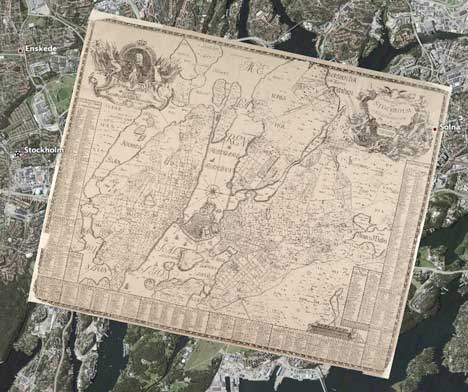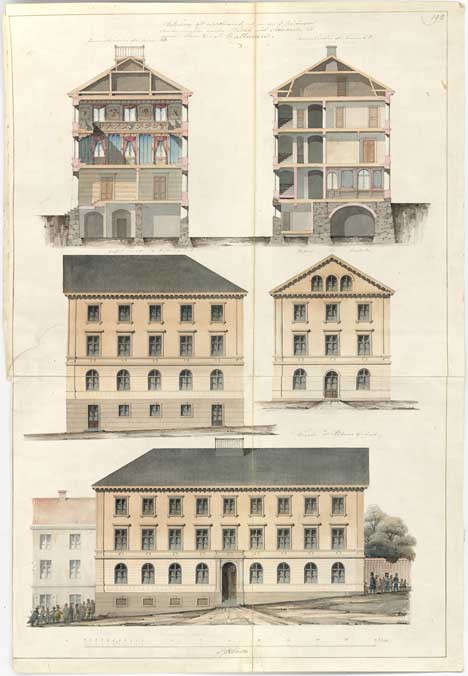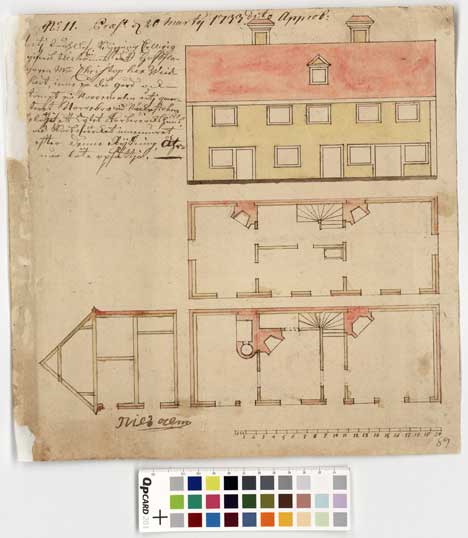A few days ago I posted a link to a dozen high resolution historical maps that the Stockholm City Archives have published as KMZ files. These proved quite popular, so the good news is that there is plenty more where that came from.
Anna Bergman, who digitized and positioned the maps, wrote in an email that they have big plans — “you have no idea how many maps the archives have,” she teased in Swedish. I asked for more info, so I got this statement back, vetted for publication:
The Stockholm City Archives is currently working on a large scanning project called Open the Archives, which will be presented in part using Google Earth. We are planning to publish maps and drawings of historical buildings. Other kinds of digital material (scanned documents and database records) that we possess will also be presented through the use of GE. We intend to publish the material on our website free for all to use.
Anna attached two images to show the kinds of documents the archives have. The first one shows Mosebacke, a Stockholm landmark, circa 1852:
Click for high resolution
The next one is of a house and dates from 1733:
Click for high resolution
That’s the same year as this map (28MB, though I love it when I get to download stuff at “2400 KB/s” — I’m definitely getting my money’s worth as a tax payer around here:-)

These documents will be georeferenced, so you can zoom in on a historical map in Google Earth and get links to drawings and outlines for historical buildings there.
So where am I going with this? These drawings and architectural plans would actually be an amazing resource for a virtual reconstruction of historic Stockholm, built with SketchUp. The drawings could provide both shape and texture to 3D buildings, while the maps pinpoint location. You could then fly around an accurate 3D rendition of Stockholm as it was documented hundreds of years ago!
And if the conversion tools mature, as I have no doubt they will, you could soon port all this work into Second Life, and then walk around in it, wearing nothing but 18th century fashions.
That’s too cool for it not to happen somehow…
[Update 0:24 UTC: Forgot to mention that Swedes are very good at this kind of geospatial enhancement of historical databases. Be sure to also read this story from a few months ago about the geospatial database of Swedish historical monuments.]


Hello there, the link to the image “1733.png” havn’t the entire path, and i cant see this beautiful work, and still “seen nothing yet”.
thanks!
Great to see some action on the Swedish Google Earth front! Another project that just cries out for a GE/Second Life treamtment is Malmö 1692 – http://www.malmo1692.nu/Eng/index.htm
Just trying to foster some inter-city ravalry to speed things up! ;-)
Hi Luis,
When you download the files try to save them as a .kmz and not to unpack them into a .png and a .kml. Since a .kmz is a zipped .kml the computer some times recognizes this and therefore helps you unpack the file even though you don’t want it to. You could also try to zip the .kml and the .png into one .zip and afterward change the extension to .kmz. That should do it!
For those interested in 3D-buildings it could also be fun to know that I started trying out SketchUp a couple of months ago. We’re planning to construct historical buildings in 3D in order to use them in GE. This will take some time since I’m new to this and want the result to be perfect. Till then we will do our best to update the mapsection frequently:O)
/Anna
well three dimensional sketchings of historial buldings will be quite useful, if is done with care and expertise. Some people in india and china, are already trying that, I have heard, but I am not sure whether the fact is true or not
http://www.searchbox.mobi
This is a beautiful idea, and I hope it catches on. It will revolutanise the map making procees, especially the historical buildings. http://www.rackeys.com
well, three imaging is an older concept, but using it to make historical building is a nice idea. But, by the way, they should hurry up, before every histrical building crumbles. But they will get many, wont they?
jpk
http://www.domaincile.com
Hey all. Quick question, I am looking for a mashup of historical atlases – say, the rise and fall of the Roman empire – to show the ebb and flow of their territorial growth against a GoogleEarth background.
Does anybody know of something like this? It would be great to show students simultaneous movements of history.
Doubly great would be to wrap a monitor screen around a spherical ball? Does this already exist?